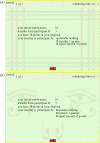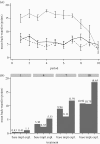Eyes are on us, but nobody cares: are eye cues relevant for strong reciprocity?
- PMID: 20031986
- PMCID: PMC2871936
- DOI: 10.1098/rspb.2009.1900
Eyes are on us, but nobody cares: are eye cues relevant for strong reciprocity?
Abstract
Strong reciprocity is characterized by the willingness to altruistically reward cooperative acts and to altruistically punish norm-violating, defecting behaviours. Recent evidence suggests that subtle reputation cues, such as eyes staring at subjects during their choices, may enhance prosocial behaviour. Thus, in principle, strong reciprocity could also be affected by eye cues. We investigate the impact of eye cues on trustees' altruistic behaviour in a trust game and find zero effect. Neither the subjects who are classified as prosocial nor the subjects who are classified as selfish respond to these cues. In sharp contrast to the irrelevance of subtle reputation cues for strong reciprocity, we find a large effect of explicit, pecuniary reputation incentives on the trustees' prosociality. Trustees who can acquire a good reputation that benefits them in future interactions honour trust much more than trustees who cannot build a good reputation. These results cast doubt on hypotheses suggesting that strong reciprocity is easily malleable by implicit reputation cues not backed by explicit reputation incentives.
Figures


Similar articles
-
Surveillance cues do not enhance altruistic behavior among anonymous strangers in the field.PLoS One. 2018 Aug 16;13(8):e0197959. doi: 10.1371/journal.pone.0197959. eCollection 2018. PLoS One. 2018. PMID: 30114252 Free PMC article. Clinical Trial.
-
Evolution of indirect reciprocity by social information: the role of trust and reputation in evolution of altruism.J Theor Biol. 2003 Aug 21;223(4):523-31. doi: 10.1016/s0022-5193(03)00143-7. J Theor Biol. 2003. PMID: 12875829
-
Evolution of indirect reciprocity.Nature. 2005 Oct 27;437(7063):1291-8. doi: 10.1038/nature04131. Nature. 2005. PMID: 16251955 Review.
-
Evolutionary stability and resistance to cheating in an indirect reciprocity model based on reputation.Phys Rev E Stat Nonlin Soft Matter Phys. 2013 May;87(5):052810. doi: 10.1103/PhysRevE.87.052810. Epub 2013 May 24. Phys Rev E Stat Nonlin Soft Matter Phys. 2013. PMID: 23767587
-
Reputation and reciprocity.Phys Life Rev. 2023 Sep;46:8-45. doi: 10.1016/j.plrev.2023.05.002. Epub 2023 May 10. Phys Life Rev. 2023. PMID: 37244154 Review.
Cited by
-
Young children are more generous when others are aware of their actions.PLoS One. 2012;7(10):e48292. doi: 10.1371/journal.pone.0048292. Epub 2012 Oct 31. PLoS One. 2012. PMID: 23133582 Free PMC article.
-
The Watching-Eye Effect on Prosocial Lying.Evol Psychol. 2015 Sep 1;13(3):1474704915594959. doi: 10.1177/1474704915594959. Evol Psychol. 2015. PMID: 37924187 Free PMC article.
-
Altruistic decisions are influenced by the allocation of monetary incentives in a pain-sharing game.PLoS One. 2019 Mar 6;14(3):e0213104. doi: 10.1371/journal.pone.0213104. eCollection 2019. PLoS One. 2019. PMID: 30840681 Free PMC article.
-
The 'spiteful' origins of human cooperation.Proc Biol Sci. 2011 Jul 22;278(1715):2159-64. doi: 10.1098/rspb.2010.2342. Epub 2010 Dec 15. Proc Biol Sci. 2011. PMID: 21159680 Free PMC article.
-
Being Negatively Cued, are People Less Cooperative? The Influence of Watching Eyes on Cooperative Behavior.Evol Psychol. 2022 Oct-Dec;20(4):14747049221140302. doi: 10.1177/14747049221140302. Evol Psychol. 2022. PMID: 36444138 Free PMC article.
References
-
- Bardsley N.2008Dictator game giving: altruism or artefact? Exp. Econ. 11, 122–133 (doi:10.1007/s10683-007-9172-2) - DOI
-
- Bateson M., Nettle D., Roberts G.2006Cues of being watched enhance co-operation in a real-world setting. Biol. Lett. 2, 412–414 (doi:10.1098/rsbl.2006.0509) - DOI - PMC - PubMed
-
- Bowles S., Gintis H.2004The evolution of strong reciprocity: co-operation in heterogeneous populations. Theoret. Popul. Biol. 65, 17–28 (doi:10.1016/j.tpb.2003.07.001) - DOI - PubMed
-
- Boyd R. T., Richerson P.2005The origin and evolution of cultures Oxford, UK: Oxford University Press
-
- Boyd R., Gintis H., Bowles S., Richerson P. J.2003The evolution of altruistic punishment. Proc. Natl Acad. Sci. USA 100, 3531–3535 (doi:10.1073/pnas.0630443100) - DOI - PMC - PubMed
MeSH terms
LinkOut - more resources
Full Text Sources
Medical
Miscellaneous

